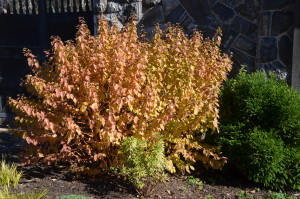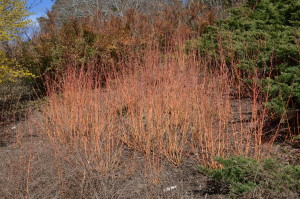Bloodtwig dogwood (Cornus sanguinea), indigenous to Europe and Asia, is an upright branched, round-topped, spreading deciduous shrub (USDA hardiness zones 5 to 7). In the wild the species matures to 8-15 feet in height and spread.
Its common name “bloodtwig” is misleading. Winter wood on 1-2 year old branches is not red. Instead, winter stems turn a striking orange-yellow at the base with reddish twigs on the tips. Fall leaf color is golden yellow some years and a blah red in others. The 3-inch long broad-elliptic to ovate leaves in spring and summer are dark green above and grayish, covered with tiny hairs underneath.
If your goal is to introduce more vibrant color into the winter landscape, select the cultivar ‘Midwinter Fire’. This compact form grows only 5 to 6 feet tall and wide after 3-4 years. It flourishes in any soil type that is well-drained and in full to partial sun. Brightest stem color occurs on young 1-2 year old wood. Annual pruning is an absolute! and take care of this chore in early spring. Every 3-4 years rein in the entire shrub by cutting back all stems to the ground in early spring (renewal pruning). Bloodtwig dogwood tends to ramble and you will want to remove root suckers to check spread of shrub.
Flat white 2-inch wide cyme flowers are not sensational but do attract numerous butterflies and other pollinators. Up close, flowers emit a stale fragrance in May to early June. In August-September blue-black fruits (1/4 inch wide drupes) form and later attract winter feeding birds. Fall color can be average yellow some years and bright orange-yellow in other years. Summer foliage is green and remains blemish-free.
Utilize as a specimen shrub or group 3-5 together for color impact in fall and winter as a hedge or short privacy barrier. Redtwig is a great choice for attracting wildlife, particularly to rain gardens. No disease or insect problems trouble bloodtwig dogwood and deer leave it alone.



 Posted in
Posted in 
